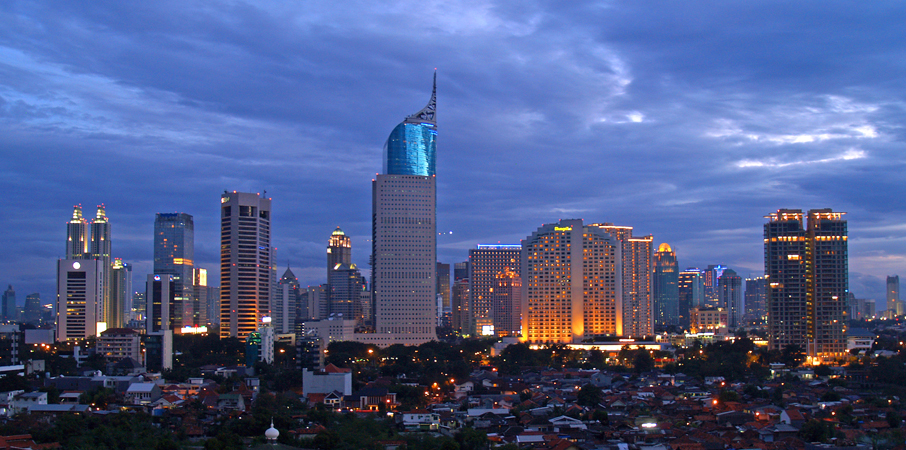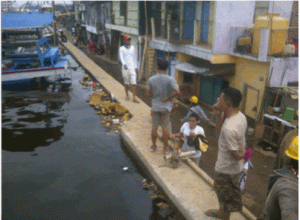Top 10 Sinking Cities in the World
Greater Jakarta is the second largest city in the world, with a population of 30 million. Currently it is ranked as having the highest rate of sea level rise in the world, on the order of ten feet (3 meters) in the last thirty years. This is primarily due to the fact that the city is sinking, adding to the quickening rate of the rising sea.
Before listing the “top ten” sinking cities, it would be good to clearly understand why sea level rise varies so much by location. Global sea level rise is primarily due to the amount of ice on land that melts, entering the sea as new icebergs, or as meltwater. Also there is a significant amount just from the thermal expansion of seawater, a direct effect of the warming. That global change in ocean height can be affected in specific coastal areas by changes to major ocean currents, and by vertical movements of the land mass. If land goes down it is called subsidence; if up, it is uplift.
As an example, if you measured sea level change in the Virginia Beach (Norfolk) area over the last century, it would appear that sea level rose about 30 inches (75 cm). However, only about a quarter of that is from global sea level change. The other 75% is from land subsidence in that region of the lower Chesapeake. Subsidence can occur for a variety of reasons such as:
- Compaction of soft sediments, particularly in delta areas at the mouth of major rivers
- Extracting water or petroleum out of the ground
- Tilting of a tectonic plate
- In the case of Virginia Beach it was all three of the above, plus an unusual factor.Thirty five million years ago, a large asteroid hit the area, causing compaction of the surrounding land, which is still occurring.
In simple terms, if the sea rises one foot, but the land goes down two feet, local sea level rise is three feet. Conversely, in areas where the land is uplifting, it can lessen or even make sea level go down. I will cover that surprising phenomenon in a future post.
Back to the Indonesian capital. In parts of the vast city, the land is sinking at an incredible rate of approximately 4 inches per year, more than three feet (one meter) in a decade. They already have severe flooding, but the worst lies ahead as noted recently in the New York Times with an excellent in-depth feature by Michael Kimmelman. Thirteen rivers run down from the mountains of Indonesia through the city. As the city keeps sinking, tall walls have been erected to keep the rivers from flooding. As illustrated to the right some are quite high, thin, structurally weak, and extremely vulnerable.
It exemplifies the challenge faced by many large coastal cities as the sea rises. Jakarta has some extreme and unique aspects however. Most homes do not have city water supply so they rely on wells. The pumping of groundwater is largely responsible for the ground sinking lower, the subsidence.To stop the sinking, the city needs to supply potable water to all the homes in the dense city, no small challenge. As the Times‘ article notes, there is grave question whether the problem is solvable, given the history of corruption, the magnitude and density of the city and the rivers running through it. New leadership is attempting some large engineering projects and expresses optimism. Some think the capital should actually be relocated. If the city does have a sudden flood due to the failure of a levee, or extreme storms and rainfall, fatalities could be in the hundreds of thousands. Time is running short to stabilize the situation.
A century ago Tokyo had a similar situation. In fact, due to pumping of groundwater, its rate of sinking was even greater than Jakarta’s is now. Following the second world war, they started an aggressive program to curtail water wells and actually inject some water back into the ground. They have had terrific success, to the point that they now have zero land subsidence. sets a good example.
Here is a list of major cities where sea level is rising at extraordinary rates, largely due to land subsidence.
Top 10 Major Cities that are Sinking
- Jakarta, Indonesia
- Manila, Philippines
- Ho Chi Minh City (Saigon), Vietnam
- New Orleans, Louisiana, USA
- Bangkok, Thailand
- Osaka, Japan
- Dhaka, Bangladesh
- Shanghai, China
- Venice, Italy
- Alexandria, Egypt
To be clear, the list is not absolute; a case could be made for a different ranking depending on the time period evaluated and other factors. In several cases the problem is not limited to the city, but relates to a regional situation. Different parts of various cities may subside at different rates, obscuring a clear ranking. In the last half century some are improving due to tight restrictions on pumping groundwater such as Tokyo and Venice. Others like Jakarta and Bangkok are sinking faster. I
Expanding the list beyond ten would see the addition of Amsterdam and the Western Netherlands, Calcutta, Mumbai, etc. Cities in the United States where subsidence significantly adds to the rate of sea level rise would likely lead with Annapolis, Maryland; Charleston, South Carolina; and Savannah, Georgia – just to name a few. Though not sinking as fast, there is the often-cited list of small countries and territories facing an imminent threat to their continued existence, such as the Maldives, Kiribati (pronounced “keer-ah-BAS”), the Marshall Islands, Tuvalu, etc.
The “top ten” list above highlighting the current cities with the greatest threat from rising sea level, should not distract us from recognizing the full scope of the problem. Worldwide there are some four thousand coastal large-cities (more than 150,000 population) and tens of thousands of smaller communities that are all vulnerable to rising seas. It is time for all of them to begin planning for adaptation.
We must rise with the tide. In the long run, adapting to higher sea level is not optional.


